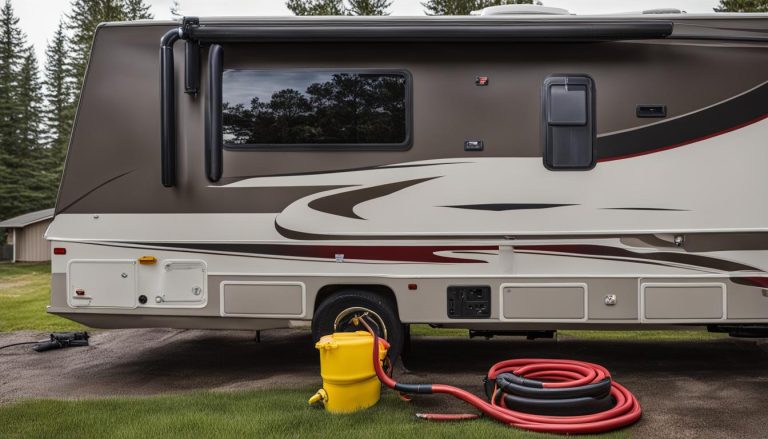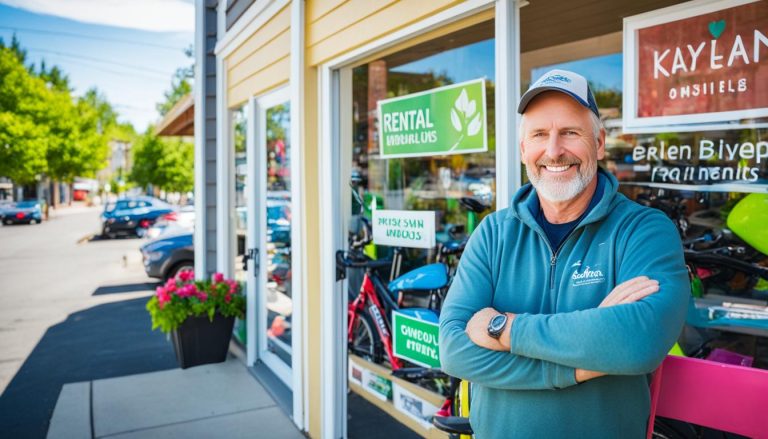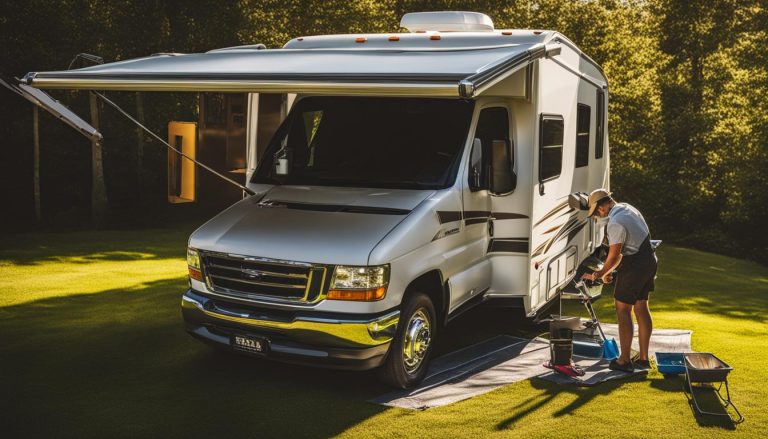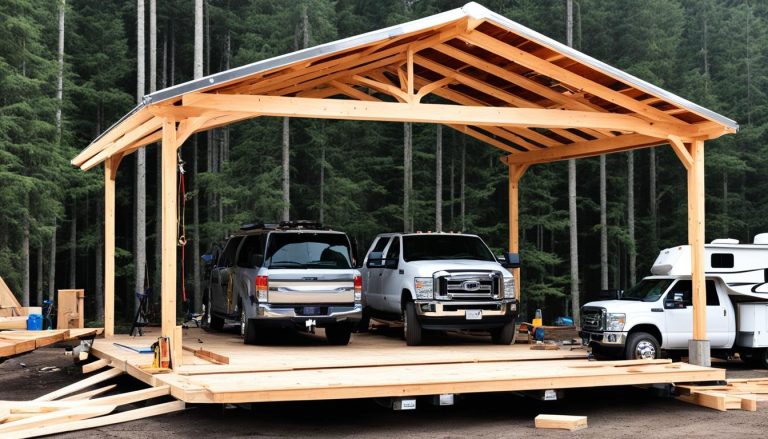RV Awning Guide: Open & Close With Ease
gorvlifestyle.com and its partners may earn a commission if you purchase a product through one of our links
As an RV owner, knowing how to operate and maintain your awning is essential for a seamless outdoor experience. Whether you’re seeking shade during a sunny day or protection from light rain, your RV awning can be a versatile asset. This article provides a comprehensive guide on how to open and close your RV awning, along with valuable tips for operation and maintenance.
Key Takeaways:
- Learn the step-by-step process to open and close your RV awning.
- Understand the purpose of RV awnings and how to use them properly.
- Discover essential maintenance practices to prolong the lifespan of your awning.
- Follow best practices for awning use to ensure safety and longevity.
- Troubleshoot common awning issues effectively.
What are RV Awnings For?
RV awnings serve a primary purpose of providing shade for outdoor enjoyment. They are designed to create a comfortable outdoor space where you can relax, dine, or entertain while protected from the sun’s rays. The shade provided by an RV awning helps to keep you cool and comfortable during hot summer days, making your outdoor activities more enjoyable.
It’s important to note that RV awnings are primarily meant for shade and are not designed to be used as rain stoppers or wind blockers. They are not built to withstand heavy rain or strong winds and using the awning for such purposes can lead to damage.
When it comes to rain, it’s advisable to retract the awning to prevent water from pooling on the fabric and causing damage. However, if you’re looking for an aftermarket solution to protect your awning from the rain, consider using Awnbrella™. Awnbrella™ is a rain deflector that can be easily installed over your awning to provide additional protection during rainy weather.
Strong winds can also pose a risk to your RV awning. Gusty or blustery weather can cause the awning to flap or become damaged. It’s recommended to retract the awning in windy conditions to avoid potential harm. Additionally, many modern RV awnings come equipped with wind sensors that automatically retract the awning when it detects strong winds, providing an added layer of protection.
Remember, always prioritize the safety of your RV and its awning by using it for its intended purpose and retracting it when necessary. This will help ensure the longevity and functionality of your RV awning for years to come.
How to Open an RV Awning
Before you can enjoy the shade and comfort of your RV awning, it’s essential to know how to open it properly. In this section, we’ll guide you through the step-by-step process of opening different types of RV awnings, from manual and hybrid to power awnings.
Preparation
The first step in opening your RV awning is to prepare your vehicle and choose a suitable location. Ensure that your RV is parked on level ground and there are no obstructions such as trees or overhead structures that may interfere with the awning operation.
Manual and Hybrid Awning Opening Steps
- Start by undoing any travel locks or straps that secure the awning during transit.
- Loosen the rafter knobs located on both ends of the awning.
- Switch the locking lever to unlock the awning arms.
- Gently walk the awning out by grasping the pull strap and gradually extending the awning fabric.
- Lock the rafter arms in place to provide stability and support.
- Extend the outer arms fully until they click into position.
Power Awning Opening Steps
- Verify the power source of your RV to ensure it is connected to a reliable electrical supply.
- Locate and turn on the awning controller.
- Using the controller, extend the awning by pressing the appropriate button or switch.
- Adjust the pitch of the awning to your desired angle for optimal shade and water runoff.
- Turn on the awning lights if available, to enhance your outdoor experience.
- If your power awning has additional features like an infrared sensor or wind sensor, activate them according to the manufacturer’s instructions.
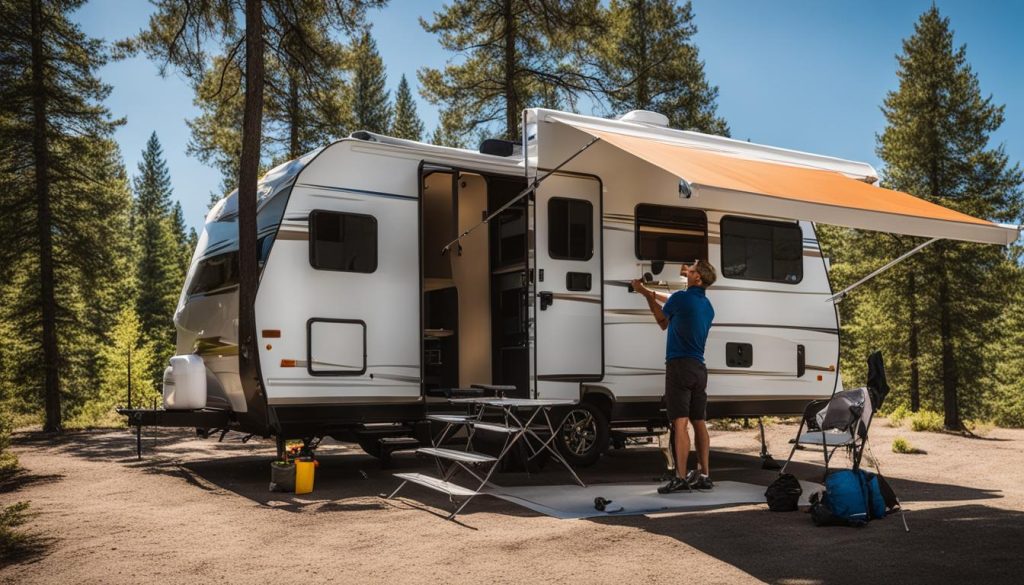
Remember to familiarize yourself with the specific instructions provided by the awning manufacturer and consult your RV’s owner’s manual for any additional guidelines. Opening your RV awning correctly will ensure a smooth and hassle-free experience, allowing you to make the most of your outdoor adventures.
How to Close an RV Awning
When it’s time to close your RV awning, the process is simple and straightforward. Follow these steps to ensure a smooth closing process:
- Remove any debris from the awning fabric to prevent damage.
- Unwrap the pull strap from around the rafter arm and extend it fully.
- Lower the outer awning arms by pulling the strap downward.
- Lower the rafter arms by releasing the rafter knobs and gently pushing them downward.
- Switch the locking lever to the unlocked position to release the fabric.
- Starting from one end, roll up the awning fabric tightly and evenly.
- Secure the awning arms by fastening the travel locks to prevent any accidental unfurling.
- Close the handle located on the horizontal arm to complete the closing process.
By following these steps, you can safely and effectively close your RV awning. Remember to check your RV’s manual for any specific instructions or guidelines.
| Step | Description |
|---|---|
| 1 | Remove debris from the awning fabric |
| 2 | Unwrap the pull strap from around the rafter arm |
| 3 | Lower the outer awning arms |
| 4 | Lower the rafter arms |
| 5 | Switch the locking lever to the unlocked position |
| 6 | Roll up the awning fabric tightly and evenly |
| 7 | Secure the awning arms with travel locks |
| 8 | Close the handle on the horizontal arm |
Awning Maintenance and Care
Regular maintenance and care are crucial for the longevity and proper functioning of your RV awning. By following these RV awning maintenance tips and implementing a routine inspection and cleaning schedule, you can prevent issues and ensure that your awning remains in top condition for years to come.
- Regular Inspection: Perform a visual inspection of your awning fabric, frame, and components. Look for any signs of damage, such as tears, fraying, or rust. Check the functionality of the awning arms, locks, and control mechanisms.
- Cleaning: Clean your awning regularly to prevent the growth of mold and mildew. Start by removing any loose debris, such as leaves or dirt, using a broom or soft brush. Then, mix a solution of mild soap and water, and gently scrub the awning fabric using a soft-bristle brush. Rinse thoroughly with clean water and allow it to air dry completely.
- Preventing Mold and Mildew: To prevent mold and mildew growth, make sure to allow your awning to dry completely before retracting it. Avoid folding or storing a wet awning, as this can lead to bacterial growth and unpleasant odors.
- Removing Stains: If your awning fabric has stubborn stains, you can use specialized awning cleaners or a mixture of water and mild detergent. Apply the cleaner to the stained areas and gently scrub with a soft brush. Rinse thoroughly and allow the fabric to dry completely.
- Replacing Damaged Awning Fabric: If your awning fabric is beyond repair, you may need to replace it. To measure for a replacement awning, extend your awning fully and measure the length from end to end, including the roller tube. Measure the width of the fabric as well. Consult your RV manufacturer or awning supplier for specific instructions on measuring and ordering a replacement fabric.
By following these awning maintenance tips and incorporating them into your regular RV maintenance routine, you can keep your awning looking great and functioning properly for years to come.

| Benefits of Regular Awning Maintenance | Tips for Cleaning Awning Fabric |
|---|---|
| 1. Prevents costly repairs or replacements | 1. Remove loose debris before cleaning |
| 2. Extends the lifespan of the awning | 2. Use a mixture of mild soap and water |
| 3. Maintains the awning’s appearance | 3. Gently scrub with a soft-bristle brush |
| 4. Reduces the risk of mold and mildew | 4. Rinse thoroughly and air dry completely |
Best Practices for RV Awning Use
To ensure the optimal use of your RV awning, it’s important to follow these best practices:
- Adjusting Awning Height: Set your awning height at a comfortable level by adjusting the telescoping legs or changing the mounting height. This allows you to tailor the shade to your preference and ensures maximum coverage.
- Water Runoff for Rain: To prevent water from pooling on your awning during rain, angle it slightly by lowering one side. This will create a slope that allows rainwater to run off, preventing damage to the fabric and potential leaks.
- Wind Sensor Sensitivity: If your awning is equipped with a wind sensor, adjust the sensitivity level based on the wind conditions in your area. Setting it too high may cause unnecessary retraction, while setting it too low may not provide adequate protection in strong winds.
- Retracting Without Activating Wind Sensor: In certain situations, you may want to retract your awning without triggering the wind sensor. To do this, simply use your awning’s manual override function or disconnect the wind sensor temporarily.
“Following these best practices will help you make the most of your RV awning, ensuring its longevity and optimal performance.”
By implementing these tips, you’ll enhance the functionality and lifespan of your RV awning, allowing for a more enjoyable outdoor experience. Always remember to consult your RV’s owner’s manual for specific instructions and safety guidelines.
Troubleshooting Common RV Awning Issues
RV awnings are essential for providing shade and protection from the elements during your outdoor adventures. However, they can encounter various issues that may require troubleshooting. Being familiar with common awning problems and their solutions can help you quickly address any concerns that arise.
Common Awning Problems
Here are some common issues you may encounter with your RV awning:
- Awning fabric damage
- Arm and knob issues
- Power awning motor malfunctions
- LED light strip troubleshooting
Let’s explore each of these problems in detail and discuss how to troubleshoot them.
Awning Fabric Damage
Awning fabric can become damaged due to wear and tear, harsh weather conditions, or accidents. Common types of fabric damage include tears, holes, fraying, or fading. If you notice any of these issues, here’s what you can do:
- Inspect the extent of damage.
- If the damage is minor, you may be able to repair it using a fabric repair kit.
- If the damage is significant, you might need to replace the entire fabric. Ensure that you measure the awning correctly to get the right size.
Arm and Knob Issues
Problems with the awning arms and knobs can hinder the smooth operation of your RV awning. Here’s what you can do to troubleshoot these issues:
- Inspect the arms and knobs for any signs of damage, such as bent or broken parts.
- Tighten any loose knobs and screws.
- If the arms are not extending or retracting properly, lubricate the moving parts with an RV slide-out lubricant.
Power Awning Motor Malfunctions
If you have a power awning, motor malfunctions can occur, preventing the awning from extending or retracting. Here are some troubleshooting steps you can take:
- Check the power source to ensure it’s properly connected and supplying electricity.
- Inspect the awning control panel for any error codes or indicators.
- If there are no visible issues, try resetting the awning motor by disconnecting and reconnecting the power.
- If the problem persists, you may need to contact a professional for further assistance or motor replacement.
LED Light Strip Troubleshooting
If your RV awning features LED light strips and they are not functioning correctly, here’s what you can do:
- Inspect the wiring connections for any loose or damaged wires.
- Ensure the LED lights are receiving power by checking the power source.
- If the issue persists, it’s advisable to consult the manufacturer’s instructions or contact customer support for troubleshooting advice.
Remember, if you are unsure or uncomfortable with troubleshooting these issues yourself, it’s always recommended to seek professional assistance to avoid further damage or safety risks.
Conclusion and Final Thoughts on RV Awning
Proper operation and maintenance of your RV awning are crucial in order to enjoy outdoor shade and avoid costly repairs or replacements. By following the step-by-step instructions provided in our comprehensive guide and implementing regular maintenance practices, you can ensure the longevity and optimal functionality of your RV awning.
Remember, the key to a well-functioning awning is proper operation. Always consult your RV’s owner’s manual for specific instructions and safety guidelines. Take the time to learn how to open and close your awning correctly, whether it’s manual, hybrid, or power-operated. Understanding the precautions and best practices for each type will help you avoid unnecessary damage and extend the lifespan of your awning.
Maintaining your RV awning is just as important as operating it correctly. Regularly inspect and clean your awning, paying attention to any signs of mold, mildew, or stains. Promptly address any damage or wear, and consider replacing the fabric if necessary. By taking care of your awning, you’ll enhance its durability and ensure it continues to provide you with shade and comfort during your RV adventures.
In conclusion, a well-maintained and properly operated RV awning is a valuable asset for any outdoor enthusiast. Follow our guide, prioritize awning maintenance, and enjoy the benefits of shade and protection it offers. Happy traveling!
FAQ
What are RV Awnings For?
RV awnings are primarily designed to provide shade for outdoor enjoyment. They are not meant to be used as rain stoppers or wind blockers. It is essential to use them only for shade to prevent damage to the awning or the RV. In case of rain, an aftermarket solution like the Awnbrella™ can help protect the awning fabric. However, it is recommended to always retract the awning in gusty or blustery weather to avoid potential damage.
How to Open an RV Awning?
Before opening an RV awning, it is important to prepare the RV by ensuring it is parked in a suitable location free from obstructions. Manual and hybrid awnings can be opened by following specific steps such as undoing travel locks, loosening rafter knobs, switching the locking lever, walking the awning out, locking the rafter arms, and extending the outer arms. Power awnings require verifying the power source, turning on the awning controller, extending the awning, adjusting the pitch, turning on the awning lights, and activating additional features like the infrared sensor and wind sensor.
How to Close an RV Awning?
When it comes time to close the RV awning, the process is essentially the reverse of opening. It involves removing any debris, unwrapping the pull strap, lowering the outer awning arms, lowering the rafter arms, switching the locking lever, rolling up the fabric, and securing the awning arms. Finally, the handle on the horizontal arm should be closed to complete the closing process.
What are the Maintenance and Care Tips for RV Awnings?
Regular maintenance and care are crucial for the longevity and proper functioning of your RV awning. This section covers various maintenance tips, including regular inspection, cleaning to prevent mold and mildew growth, stain removal techniques, and instructions for replacing damaged awning fabric. It also provides guidance on measuring for a replacement awning.
What are the Best Practices for RV Awning Use?
To ensure the optimal use of an RV awning, it is important to follow best practices. This section provides tips on adjusting the awning height, enabling water runoff for rain by sloping the awning slightly, setting the wind sensitivity level on a wind sensor for automatic retraction, and retracting the awning without activating the wind sensor.
How to Troubleshoot Common RV Awning Issues?
RV awnings can encounter various issues that might require troubleshooting. This section offers a comprehensive guide to troubleshooting common problems such as awning fabric damage, arm and knob issues, power awning motor malfunctions, and LED light strip troubleshooting. It provides solutions and tips to resolve these issues effectively.
What is the Importance of Proper RV Awning Operation and Maintenance?
Proper operation and maintenance of an RV awning are essential for enjoying outdoor shade and preventing costly repairs or replacements. By following the step-by-step instructions in this guide and implementing regular maintenance practices, you can ensure the longevity and optimal functionality of your RV awning. Remember to always consult your RV’s owner’s manual for specific instructions and safety guidelines.


